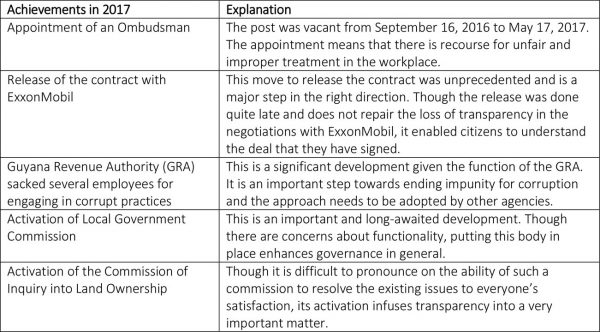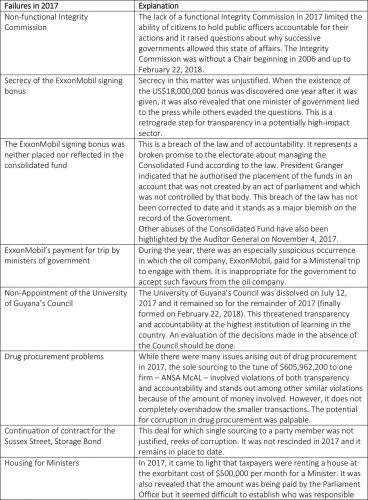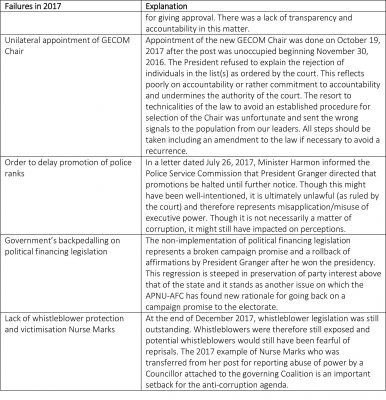(A column by Transparency Institute Guyana Inc)
Transparency International’s Corruption Perception Index 2017 (CPI 2017) was published on February 21, 2018 and for the second consecutive year, Guyana’s position has improved. In considering the index, it is important to understand its meaning, clarify the difference and link between corruption conception and corruption perception, and understand what might have contributed to the improvement in Guyana’s standing.
Corruption Conception
Corruption conception is essentially what is regarded as corruption. From one person to another, this can be positioned along a continuum ranging from the most permissive stance to the most judgmental (Navot & Beeri 2017). The most permissive stance requires conviction through court proceedings to concede that there was corruption (Navot & Beeri 2017). In the Guyanese context, we have heard this position advanced. The underlying argument is that corrupt acts are illegal and perpetrators would be brought before the courts and convicted, and without such convictions, it is improper to level accusations of corruption. There are two glaring shortcomings in this argument.
On the one hand, the requirement of convictions ignores (or counts on) the systemic problems in law enforcement in the country. If the police force is as corrupt as it is viewed by the public and politicians, convictions for corrupt acts would likely be lacking or otherwise undermined by corruption. On the other hand, the requirement of convictions as proof of corruption overlooks the absence of laws protecting whistleblowers (legislation was recently approved by parliament) and individuals who might provide the evidence needed to justify prosecution for corrupt acts. The most tolerant position is problematic, but one can understand how it might fit into a defensive stance.
At the other end of the continuum, is the most judgmental conception wherein any wrongdoing is regarded as corrupt (Navot & Beeri, 2017). This point-of-view recognises no distinction between corruption and illegality or poor governance and decision-making. The extent to which a judgmental conception prevails at the individual level is not really known. However, a judgmental conception might seem like an attractive approach to changing opinions about a sitting government.
Neither extreme in corruption conception is a good representation of reality. A more accurate conception lies somewhere in-between (Navot & Beeri, 2017). Transparency International defines corruption as the abuse of entrusted power for private gain. This definition provides broad coverage; from the various forms of low-level acts to grand corruption that might be perpetrated by politicians and others that operate at the highest levels.
Corruption Perception and the CPI 2017
Corruption perception is about the perceived frequency with which corrupt acts are done and the frequency with which people encounter corruption in their daily lives. A low rank (large numerical value of the rank) on CPI means that compared to the other countries, people believe that corrupt acts occur in the target country frequently and is hence more pervasive. In addition to actual corruption, the CPI addresses the potential for corruption which can exist in the absence of transparency and accountability.
One of the often-overlooked issues about the CPI is that is it not entirely about government and particularly the executive branch. The data that contributes to the calculation of the index for Guyana addresses issues in several arms of government including the executive, judiciary, courts, law enforcement, and the public health system, but it also focuses on politicians in general, business and the interaction of business with government. Nevertheless, corruption perceptions in Guyana does appear to be strongly linked to perceptions about corruption in government and people may overlook the private sector and many forms of everyday acts such as use of connections and bribery to facilitate basic transactions or to circumvent requirements and procedures in business, interfacing with government agencies, dealing with representatives of utility companies and generally to gain advantages in society.
The change in government in 2015 was followed by an improvement in Guyana’s ranking on the CPI 2016. In fact, Guyana’s position improved by eleven places based on a five-point increase (from 29 to 34) in corruption perception score. Given the known correlation between a change in government and optimism among citizens in Latin America (Johnson, 2015), TIGI indicated then that whether the upward shift in the ranking was indicative of gains in the fight against corruption and reduction in people’s experience of corruption would be substantiated if the improvement holds over time. It was also noted that the improvement in the score lacked statistical significance.
The CPI 2017 covers a period that is just on the borderline of the known honeymoon period (two years on average) and instead of holding or regressing, Guyana climbed once again in the rankings. On this occasion, the country moved 17 places (from 108) upward to the rank of 91 based on a four-point gain (from 34 to 38). Since 2015, Guyana has therefore improved in rank by 27 places (and 9 points). Though the gain from 2016 to 2017 also lacks statistical significance, the overall gain in the period from 2015 to 2017 is statistically significant (at the 5% level).
TIGI believes that the upward movement in the corruption score over the period 2015 to 2017, indicates that the citizens perceive that there have been gains in the fight against corruption since the APNU+AFC government took office. This conclusion is corroborated by survey data collected in regions 3, 4, 6, and 10 in 2017. The responses of 453 randomly selected survey respondents (in the four regions) to the question of the amount progress made in the fight gains corruption in the previous two years (in the respective regions) were scored on the scale: 1 – we moved backward a lot, 2 – we moved backward a bit, 3 – no progress, 4 – a small amount of progress, 5 – a lot of progress and has an average of 3.63 (95% confidence interval: 3.54 – 3.73) which suggests that there was some perceived progress (very small) in the fight against corruption since the Coalition Government took office.
We must therefore conclude, in spite of the many issues that have emerged, that Guyana is generally on the right track. This could also mean that citizens are correctly distinguishing between corruption which has an element of private gain and wrongdoing, government lethargy and illegality in general. Nevertheless, the upsurge in the corruption rankings and corruption perception score does not mean that all is well or that Guyana is no longer corrupt. In reality, Guyana remains among the most corrupt countries of the world and one can readily point to recent occurrences such as the continuation of the storage bond deal and the drug procurement issues during 2017 that bear the stench of corruption.
What Can Account for the Guyana’s Improvement in the CPI?
The data for the CPI 2017 was collected at various points within the year depending on the data source (five sources used for Guyana). This means that some events especially in the latter part of the year are unlikely to have affected the results.
In the year 2017, there were a few victories in the fight against corruption but there were also many setbacks. Below, we identify occurrences in the year that might have impacted on corruption perceptions. It is important to note that this list may not be exhaustive, but it should provide a fair overview of what transpired in 2017.









